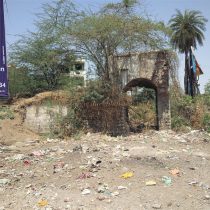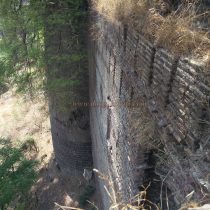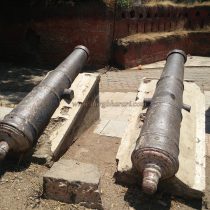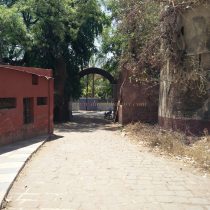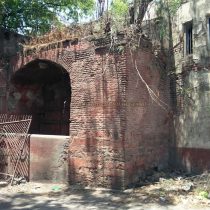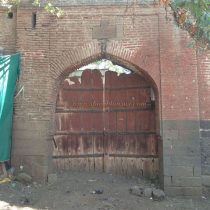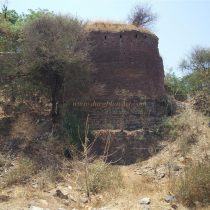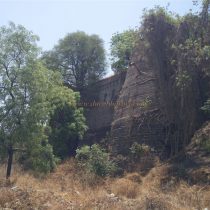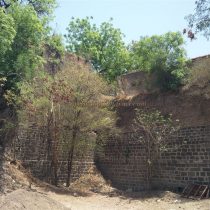MASTGAD
TYPE : GROUND FORT
DISTRICT : JALNA
HEIGHT : 0
GRADE : EASY
In the center of Jalna city is an unfamiliar fort called Mastgad. This fort, which is not on the list of trekkers, is not known to many people living in Jalna city itself. The fort, which is in the possession of Jalna Municipal Council, has been destroyed due to negligence. The office of the Municipal Council here has now been shifted to another place and this place has been abandoned. This part of the citadel is present on the banks of river Kundalika and is on the hummock of the city, a water supply tank has been constructed here. This fort was built by Nizam-ul-Mulk in the early 18th century in the city of Jalna, although today only the citadel remains. As this part is known as Mastgad, we come to this area but no one knows about the fort, so when we come here, we should inquire about the old office of the municipality.
...
This square-shaped fort is spread over an area of about 2 acres and except for the ramparts on the roadside, the remaining ramparts on the three sides are still standing. The construction of the bottom of the fort is done from limestone while the upper construction is done with bricks. The arch of the east-facing wooden gate of the citadel is still standing strong. There is a Persian inscription on the door mentioning that it was built by Asafjah in 1723. The door has been permanently closed and a road has been constructed by breaking through the adjacent ramparts. This is the place where you enter the fort. The interior buildings may have been leveled during the construction of the municipal office at the citadel, but the other structures, such as the fort's ramparts, the curtain wall on it, the barrage on the ramparts remain. All these things can be seen while entering the fort. Upon entering the fort, one can reach the bastion adjacent to the river. From this bastion, you can see the other two bastions facing the river. Also on the middle bastion to the west of the fort is the tomb of a Sufi saint. There is an inscription in Urdu on the wall next to this tomb. Two medium-sized cannons can be seen on a quadrangle structure in the courtyard of the fort. If you walk around the fort from the outside, you can see three bastions on the riverside, two on the west, and one on the east. The height of this rampart along the river is about 35 feet. In medieval times, Jalna was a bustling city and an important market. The city had a large weaving business. The original name of the city of Jalna was Hirval which is mention in Leela Charitra. Over time, changes like Jalnapur to Jalna were taking place in its name. The city of Jalna was under the control of the Mughals during the reign of Akbar. Abu Fazl, the author of the Akbarnama, lived here for some time. This part then joined the Nizamshahi. During the reign of Malik Amber, the city developed on a large scale. During this period, Jamshed Khan dug the Moti Talav to the west of Jalna city and built a monastery in the city. The Black Mosque near the Mecca Gate in the city was built during this period. He also built 5 small lakes in the city. While Diller Khan was marching on Bijapur, Maharaj plundered the Mughals area from the Bhima river to the Godavari river. After looting the cities of Dharangaon and Chopda, on 16 November 1679, he came to Jalna, a town on the Kundalika river north of Aurangabad. At this time Prince Muazzam was in the nearby city of Aurangabad but regardless of that, Shivaji Maharaj attacked the city of Jalna and looted the whole city. This lasted for four days. After looting, on 22nd November 1679, Maharaj and the Maratha army reached Patta fort near Akola with all the loot. As the city of Jalna was a major market for the Mughals, it was surrounded by a fort and had two gates, the Murti Wes and the Mirza (Hyderabad) Gate. Although the entire fortifications of this fort were destroyed due to the growth of the city, both the gates of the fort still exist today. Mastgad did not exist at this time. In 1723, Nizam-ul-Mulk Asafjah asked his chief, Kabil Khan, to build a fort in the city of Jalna, and he built it on a hill on the east bank of the Kundalika river. This fort is today known as Mastgad. Later Tukoji Holkar captured the fort. In April 1805, Colonel Murray, a British officer, attacked the Jalna fort, which was in the possession of Yashwantrao Holkar but was unable to conquer it. While the Jalna fort was under his control, Yashwantrao Holkar repaired it to some extent. For some time after the death of Yashwantrao Holkar, the Shinde family dominated here. In 1803, Colonel Stevenson defeated the Marathas in the battle of Asai near Bhokardan. After the Marathwada liberation struggle of independent India, Jalna taluka was included in Aurangabad district. Although people have forgotten the history of this fort over time, even today this fort stands tall to tell the story of Yashwantrao Holkar.
© Suresh Nimbalkar

